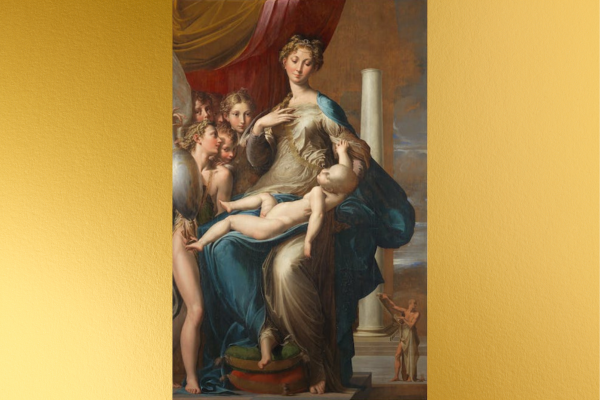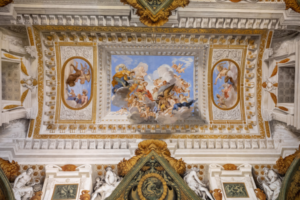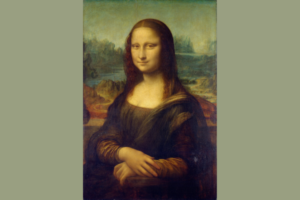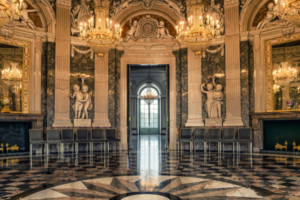In the rich and diversified tapestry of art history, Mannerism emerges as an intriguing interlude between the classical harmonies of the High Renaissance and the drama of the Baroque. Born in the tumultuous corridors of 16th-century Italy, Mannerism is often seen as a reaction to the humanism and perfect symmetry that characterized the works of masters like Leonardo, Michelangelo, and Raphael.
At its core, Mannerism is a rupture, a conscious decision by artists to distort and exaggerate proportions, colors, and perspectives to create a distinct visual language. Rather than seeking idealized perfection, Mannerist artists pursued deeper expression, even if that meant surpassing the boundaries of reality and convention.
The purpose of this article is not just to present a dry definition or recite historical dates. We aim to dive deep into this artistic current that, for a brief period, captured Italy’s imagination and led it to explore the limits of expression. Let’s together uncover the secrets hidden in brushstrokes, in colors, and in the distorted silhouettes that define Mannerism in Italian painting.
History and Cultural Context
Transition from the High Renaissance to Mannerism
The era of the High Renaissance, spanning much of the 15th century, was a time of optimism, exploration, and a revival of interest in classical arts and sciences. Italy, especially cities like Florence and Rome, became the epicenter of a movement that produced some of the most iconic masterpieces in art history. Masters like Leonardo da Vinci, Michelangelo, and Raphael dominated the art scene with their quest for harmony, proportion, and idealized beauty.
However, as the 16th century progressed, the climate of optimism began to give way to a sense of uncertainty. Sociopolitical changes, religious conflicts, and a growing sense of instability began to influence the art of the time. Mannerism then emerged as a way for artists to express themselves amidst these tensions.
Main historical and cultural events that influenced the art of the time
The late 15th and early 16th centuries were marked by various significant events. The sack of Rome in 1527 by German mercenaries was a devastating blow to the Italian peninsula, leading to a palpable sense of decline and chaos. Moreover, the Protestant Reformation was redefining Europe’s religious landscape, causing questions and conflicts that were reflected in the arts.
Differentiation between the Renaissance and Mannerism
While the Renaissance emphasized harmony, balance, and an almost religious adoration for the human form and nature, Mannerism was more interested in exploring the unconventional. It was less about replicating reality and more about interpreting it. Mannerist artists distorted proportions, used unexpected colors, and created compositions that challenged established norms, often resulting in works that seemed strange but deeply emotive.
Main Characteristics of Mannerism in Painting
Elongated and Stylized Figures: In many Mannerist paintings, human figures are depicted with exaggeratedly long limbs and slender bodies, giving a sense of elegance and, at times, strangeness.
Intense Use of Colors: Color palettes were often dramatic and contrasting, with bright tones not commonly found in nature.
Distorted Perspective: Instead of the meticulous linear perspective of the Renaissance, Mannerist artists preferred to distort spaces, often creating depths that seemed unattainable or impossible.
Complex Compositions: Unlike the clarity and order of the Renaissance, Mannerist compositions were often filled with tension, with overlapping figures and contorted positions.
By understanding the historical context and distinctive features of Mannerism, it becomes clear that this movement was a direct response to the changing world of the 16th century. And through this response, the artists of the time found new and exciting ways to express their visions and emotions.
The Distinctive of Mannerism: Characteristics and Masters that Defined a Movement
Elongated and stylized composition of figures
One of the first things noticed when observing a Mannerist painting is the elongated and stylized representation of human figures. These exaggerated bodies challenge classical proportions, introducing a surrealist elegance to the compositions. Instead of depicting the human form in its natural proportion, Mannerist artists stretched and contorted the bodies, resulting in sinuous silhouettes that danced across the canvas.
Use of bright and contrasting colors
While Renaissance artists sought natural and harmonious colors, Mannerists revolutionized with bold and contrasting palettes. The liberal use of vibrant blues, deep reds, and luminous greens captured the viewer’s attention and amplified the dramatic atmosphere of their works.
Distorted spaces and perspectives
Mannerism also challenged the conventions of linear perspective, creating spaces that seemed to extend infinitely or compress in illogical ways. This distortion of perspective contributed to a sense of discomfort and unpredictability in the depicted scenes.
Exaggerated expressions and complex postures
Where the Renaissance prioritized serenity and balance, Mannerism delved into the complexity of human emotions. Facial expressions were often intensified, displaying ecstasy, agony, or profound contemplation. Additionally, the postures of the figures were twisted, capturing moments of movement or tension.
Atmosphere of tension and instability
All this play on proportions, colors, and expressions culminated in a palpable atmosphere of tension. The world portrayed in Mannerist canvases was one of instability, where classical order was replaced by an unpredictable dance of forms and emotions.
Main Artists and Works
Pontormo: His work “The Deposition from the Cross” is an excellent example of elongated figuration, with characters seeming to float in an undefined space, laden with emotion.
Parmigianino: In “Madonna of the Long Neck,” we see the extreme stylization of figures, particularly in the Virgin’s elongated neck, and an innovative use of color.
Rosso Fiorentino: His “Descent from the Cross” exemplifies the vibrant color palette and twisted postures that define many Mannerist works.
Other artists, like Bronzino and Tintoretto, also brought their unique visions to the movement, further enriching the tapestry of Mannerism.
In exploring Mannerism, we not only appreciate the technique and innovation of the artists but also delve into a period of history rife with changes and discoveries. And at the heart of this movement, we find a boldness of expression that still resonates deeply with us today.
The Pioneers of Mannerism and their Cultural Legacy
Pontormo and “The Deposition from the Cross”
Jacopo Carucci, better known as Pontormo, was one of the leading figures of Mannerism. His masterpiece, “The Deposition from the Cross”, captures the essence of the movement with its ethereal color palette and elongated figures. At the center of the composition, Christ’s body is surrounded by moving figures that, with their twisted postures and anguished expressions, carry the emotional weight of the moment. The absence of a defined background and the predominance of pastel tones create an almost dreamlike atmosphere, challenging Renaissance conventions.
Parmigianino and “Madonna of the Long Neck”
Girolamo Francesco Maria Mazzola, commonly known as Parmigianino, offers a dramatic example of Mannerist stylism in his “Madonna of the Long Neck”. The Virgin Mary is presented with exaggerated proportions, with her extended neck evidently highlighted. This elongation creates a sense of elegance but also strangeness, challenging the conventional perception of the human form. The illusory space and the distorted child figures surrounding her reinforce the work’s Mannerist aesthetic.
Rosso Fiorentino and “The Descent from the Cross”
Rosso Fiorentino, a contemporary of Pontormo, brought an intense and vibrant color palette to Mannerism. In his “Descent from the Cross”, the figures seem almost luminous against a dark background, highlighting the drama of the depicted moment. The exaggerated expressions and twisted postures of the characters capture the turmoil and emotion of the biblical event, while the overall composition conveys a sense of movement and imbalance.
Other notable artists and their contributions to the movement
Besides those already mentioned, artists such as Bronzino, with his intriguing portraits, and Tintoretto, with his vast religious scenes, also made invaluable contributions to Mannerism. These artists, each in their own way, expanded and enriched the core features of the movement, adding their own interpretations and innovations.
Influences of Mannerism in Popular Culture
While Mannerism might seem distant and specific to its time, its influences permeate popular culture even today. In contemporary cinema and photography, we can observe the use of contrasting colors and distorted compositions reminiscent of Mannerist stylism. In fashion, the elongation and stylization of the human form have been explored by avant-garde designers. Even in music and literature, the spirit of experimentation and challenging conventions, so central to Mannerism, can be recognized.
In summary, Mannerism, through its pioneering artists and iconic works, not only redefined the art of its time but also sowed ideas and aesthetics that continue to influence artistic and cultural expression in various forms to this day.
Mannerism Beyond Painting: Influence and Legacy in Various Cultural Spheres
How the style manifested in other art forms
Literature: During the Mannerist period, literature also reflected a tilt towards the complex and the exaggerated. Poets and writers began to adopt more ornate styles, often prioritizing form and elaborate language over simplicity. Just as in painting, content could be distorted or presented in unconventional ways, challenging readers’ expectations.
Sculpture: In sculpture, artists like Giambologna displayed Mannerist traits by creating elongated and contorted figures, often engaged in spiraling motions. His works, such as “The Rape of the Sabine Women”, exemplify the dynamic tension and movement that were hallmarks of Mannerism.
Influence on contemporary fashion and design
Mannerism, with its emphasis on exaggeration and distortion, found resonance in contemporary fashion, especially on high-fashion runways. Designers have toyed with proportions, stylizing and elongating silhouettes, and incorporating dramatic color palettes into their collections. In interior design, a return to ornate patterns and strong contrasts can be seen as an echo of Mannerist stylism.
References to Mannerism in pop culture and cinema
Cinema, in particular, has embraced the Mannerist aesthetic on various occasions. Period films, like those portraying the Renaissance or the Baroque period, frequently incorporate Mannerist visual elements, whether in costumes, settings, or even in the composition of some scenes. Moreover, art film directors often adopt the intense color palette, perspective distortion, and dreamlike atmosphere characteristic of Mannerism.
Pop culture also has its roots in the past, and it’s not uncommon to find visual references to Mannerism in music videos, album covers, and even in video games.
Critiques and Perceptions Over Time
From its inception, Mannerism was subject to various critiques and interpretations. Some contemporaries saw the style as decadence or a rejection of the classical ideals of the Renaissance. This perception persisted in certain academic circles, where Mannerism was at times viewed as a “transition period” or an “anomaly” between the Renaissance and the Baroque.
However, as time passed and art studies evolved, Mannerism began to be more appreciated for its uniqueness and its ability to capture the tension and uncertainty of its time. 20th and 21st-century artists and critics, in particular, re-evaluated the movement, acknowledging its influence and inherent value.
Ultimately, Mannerism, with its daring and innovation, has stood the test of time, influencing generations of artists and continuing to fascinate and inspire art admirers worldwide.
Mannerism: From Controversial to Celebrated
Acceptance and rejection at the time
The innovation and audacity of Mannerism did not go without heated debates during its prime. For many, the style was seen as an unnecessary break from the classical norms set by the Renaissance. While some patrons and art enthusiasts celebrated Mannerism’s exaggerated expression and experimentation, others viewed it as an inferior art form, a decadence, or even a corruption of the “true” artistic ideal.
Critics often centered on the perception that Mannerism, with its stylization and distortion, was more interested in showcasing the artist’s skill than in capturing truth or the inherent beauty of the world. The debate was not only aesthetic but also philosophical, questioning the purpose and function of art in society.
Reevaluation of Mannerism in the 20th and 21st centuries
With the onset of modernity and rapid shifts in the artistic landscape during the 20th century, scholars began to reexamine Mannerism in a different light. The movement was recognized for its ability to capture the uncertainty and complexity of the human condition, themes that became central to many modern and contemporary artists.
The 21st century, with its emphasis on diversity and reevaluation of historical standards, saw Mannerism celebrated for its innovation and unique approach to form and content. Museums, galleries, and curators reassessed and recontextualized Mannerist works, positioning them as central pieces in the evolution of European art.
Comparison with other artistic movements and its legacy
Beside the Renaissance and Baroque, Mannerism offers a fascinating counterpoint. While the Renaissance emphasized balance, proportion, and clarity, Mannerism challenged these ideals with its emphasis on tension, distortion, and emotion. Subsequently, the Baroque, with its theatricality and drama, can be viewed as an extension or evolution of some Mannerist ideas, albeit with its own distinct characteristics.
The legacy of Mannerism can be observed in subsequent movements like Romanticism, Expressionism, and even certain aspects of Surrealism. All these styles, in some way, explore the tension between reality and representation, between form and content, central themes to Mannerism.
In conclusion, while Mannerism may have been a subject of controversy in its time, its lasting impact and influence on subsequent artistic movements are undeniable. What was once viewed as odd or deviant is now celebrated as a testament to the enduring human desire to innovate, challenge, and express.
Summary of the main points discussed in the article
Throughout this article, we delved into the depths of Mannerism, an artistic current that, although born in the shadow of the Renaissance, solidified its own mark on the tapestry of art history. Here’s a recap of the main topics we explored:
Origins of Mannerism: Emerging after the High Renaissance, Mannerism presented itself as a response both to that prior era and to the social and religious turmoils of the time.
Distinctive Features: From elongated and stylized figures to vibrant color palettes and atmospheres laden with tension, Mannerism challenged established conventions and celebrated individual expression.
Key Artists and Works: Pontormo, Parmigianino, and Rosso Fiorentino, among others, brought to life the movement’s core ideas through their iconic works.
Manifestations beyond painting: Mannerism influenced other realms of art and design, leaving its mark on sculptures, literature, and even contemporary fashion.
Evolving Perceptions: Initially met with mixed sentiments, Mannerism was re-evaluated in the 20th and 21st centuries, being recognized for its unique contribution to art.
The Importance of Mannerism in the Trajectory of Italian Art
Mannerism plays a pivotal role in Italian art by bridging a gap between the Renaissance and the Baroque, two of the most influential artistic currents in history. Besides serving as a bridge between these two movements, Mannerism also provides a glimpse into the cultural psyche of the era, reflecting the complexities, doubts, and tensions of 16th-century society.
Encouragement for personal appreciation and deeper exploration of the topic
The world of art is vast and diverse, and Mannerism is just one of many currents that offer insights into humanity and its creative expression. We encourage readers to dive deeper into this and other movements, visiting museums, reading specialized literature, and above all, forming their own opinions and interpretations.
After all, the true beauty of art lies not just in technique or history, but in the unique and personal interaction each individual has with it. Whether driven by curiosity or passion, the invitation is open for you to continue your journey through the captivating universe of Mannerism and beyond.



